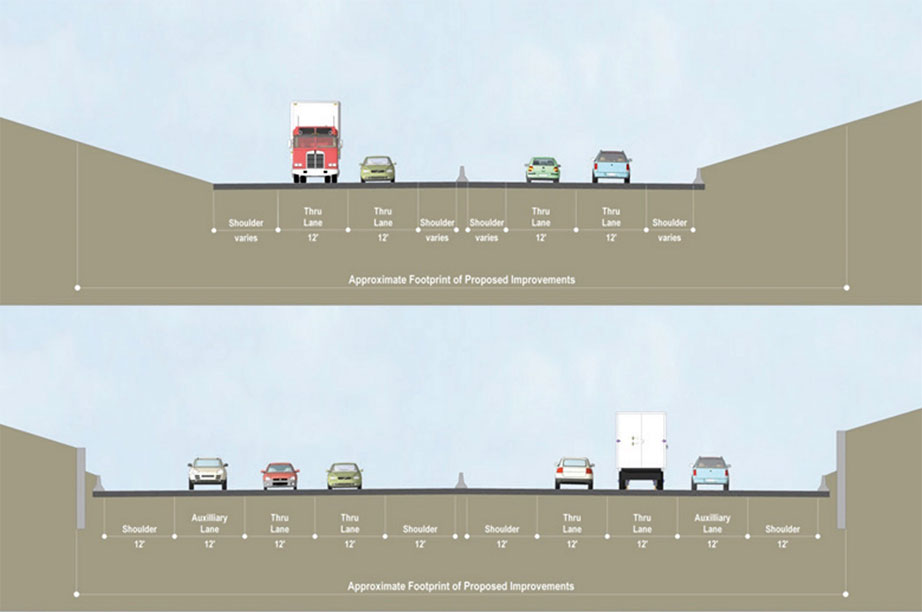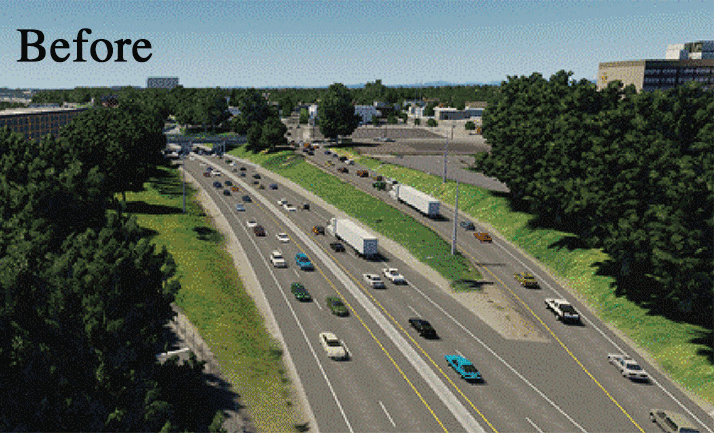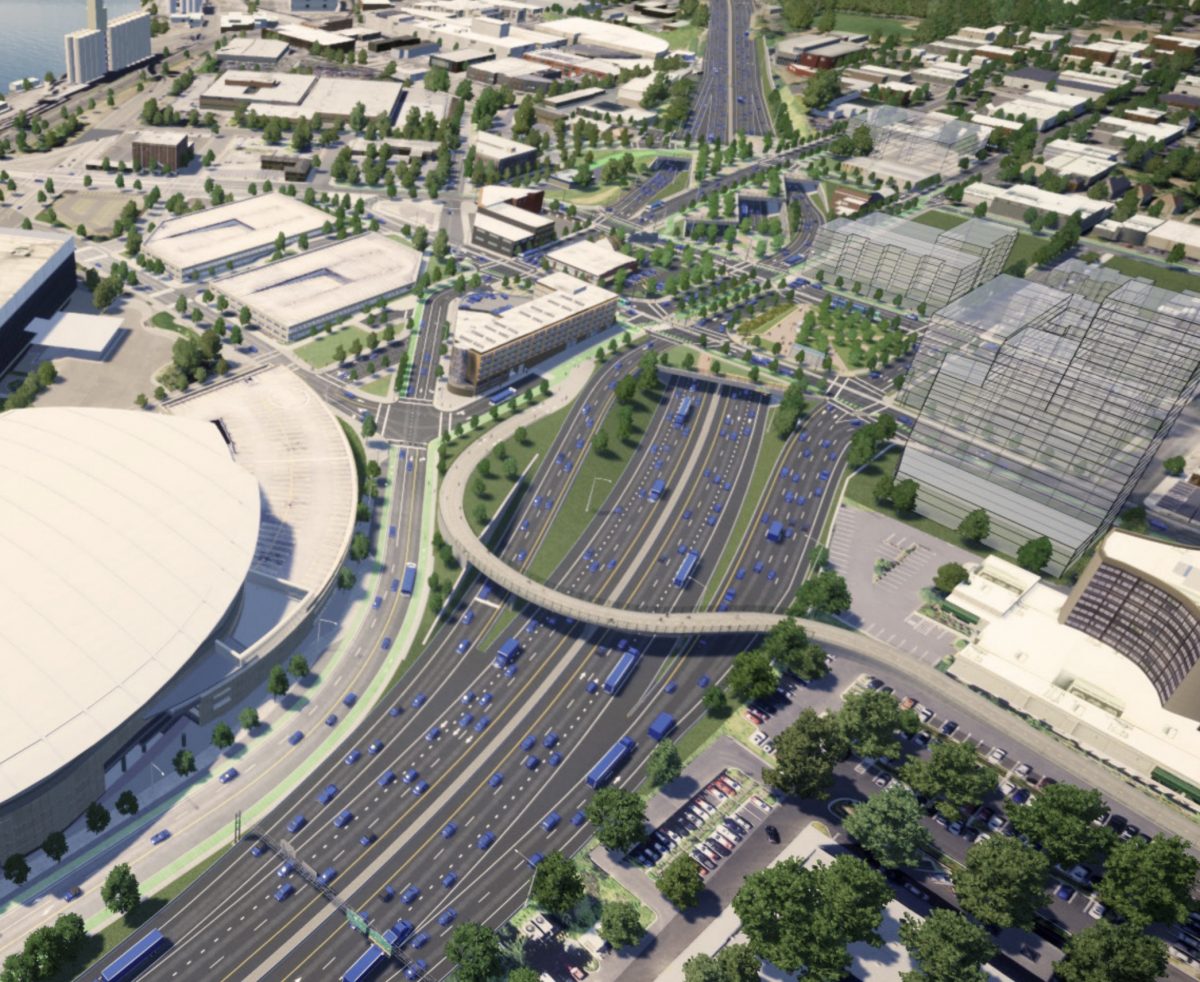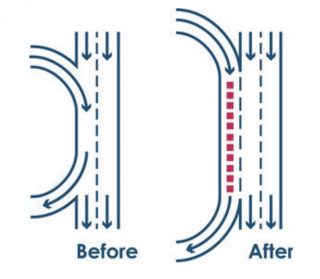
ODOT says this should not be considered a large-scale expansion of the freeway.
(Graphic: ODOT I-5 Rose Quarter Environmental Assessment)
As you can see in the cross-sections above, the Oregon Department of Transportation’s I-5 Rose Quarter project would significantly widen Interstate 5 through Portland’s central city. And, if the project achieves ODOT’s goals for fewer crashes and faster speeds, it would also increase the number of people who drive through the corridor.
These seem like obvious facts. I can’t believe I even need to point them out. But with just 20 days left in the EA comment period, I’m afraid many people are being misled.
“It’s imprecise to say the Rose Quarter Plan will build more freeway lanes… Saying it builds more freeway lanes leaves the impression that there will be a large scale expansion of the freeway.”
— Don Hamilton, ODOT
ODOT says they can add approximately 3.2 miles of new driving lanes and shoulders to I-5 without actually widening the freeway. They also want us to believe that an estimated $250 million in new freeway facilities will not increase the number of drivers or create an incentive for more people to use the freeway. With no induced demand, coupled with a future full of high-tech cars and stronger emission regulations, ODOT says this project would actually contribute to a reduction in emissions.
What ODOT is pitching sounds too good to be true. Because it is.
ODOT knows freeways expansions and projects that increase driving capacity are controversial and politically dicey (especially in Portland). So they’ve come up with clever ways to blur reality. The trouble is, similar to how they hid images of wider freeways and lied about greenhouse gas emissions in the marketing of their failed Columbia River Crossing project, they are misleading the public with their I-5 Rose Quarter plans.
Believe what we say, not what you see

Oregon State Senator Lew Frederick represents the district this project runs through. He also sits on the powerful Joint Committee on Transportation. At a meeting with constituents Saturday morning, Portlander Kiel Johnson (who lives in Frederick’s district) asked him about the project. “He disagrees they are widening [the] freeway,” Johnson shared via Twitter. Asked to elaborate, Johnson wrote to us that Sen. Frederick said, “They are not adding two lanes but a series of on and off ramps.”
Sen. Frederick works for the people, not ODOT. Yet his answer came directly from the agency’s talking points.
According to the project’s environmental assessment (EA), ODOT wants to add 4,300 feet of freeway lanes in the northbound and southbound directions (8,600 feet or 1.6 miles total). But they don’t call them new lanes. ODOT insists on the more benign terms “auxiliary lanes” or “ramp-to-ramp” lanes (they even show a graphic in the EA (at right) that shows a version of the lanes that does not match what they propose in the project). However, as you can see in a graphic shown on page 9 of the EA (below), the new northbound lanes are ramp-to-ramp-to-ramp-to-ramp-to-ramp. And in the southbound direction they are ramp-to-ramp-to-ramp-to-ramp.
In addition to these new lanes, ODOT plans to widen the freeway by 48 more feet to make room for four, 12-foot wide shoulders on the inside and outside of the freeway in each direction for the same length as the new lanes.
Several months ago I wrote that this project was adding new freeway lanes. I got an email shortly after from ODOT spokesman Don Hamilton. “It’s imprecise to say the Rose Quarter Plan will build more freeway lanes,” he wrote. “It adds shoulders and auxiliary lanes (on-ramp to the next off-ramp)… But does not create additional through lanes and doesn’t widen the overall footprint of I-5. Saying it builds more freeway lanes leaves the impression that there will be a large scale expansion of the freeway.”
How can Hamilton say that?
Note how he said it doesn’t widen the overall “footprint”. As you can see in the lead graphic (from page 10 of the EA), ODOT has cleverly defined a very wide “footprint”. Then they propose to widen the freeway by over 24-feet, yet because it stays inside that pre-defined footprint, they can say the footprint doesn’t get larger.
Is that an honest explanation of the plans or willful obfuscation and spin?
BikePortland relies on financial support from readers like you.
Please join hundreds of other readers and
subscribe for $10/month or
make a one-time payment today!
When ODOT says the project, “Does not create additional through lanes and doesn’t widen the overall footprint of I-5,” how do most people interpret that? We know what Sen. Frederick thinks.
At last week’s open house, I asked Hamilton how long a lane has to be before it goes from an auxiliary lane to just a standard freeway lane. I also shared my concern that ODOT is using words like this to make the project sound better.
“To manipulate the language a little bit?” Hamilton interjected, unsolicited. “Yes,” I said, “Is ODOT doing that?” He didn’t respond directly to that question (partly because he avoided it and partly because I didn’t force him to).
“I don’t have an answer to the question of when auxiliary lane becomes a through lane,” Hamilton said.
“Why not just call it a through lane?” I asked.
“Because it doesn’t go very far,” he replied.
“If you’re connecting two freeways [more than three-quarters of a mile from each other], that’s a lane,” I countered.
Then he pivoted. “We’ve got three interstates coming together in that stretch. It hasn’t been opened up in 50 years. We’re trying to give it a little more breathing room.”
The capacity question
ODOT is playing a similar game on whether or not the project will add capacity. On page 26 of the EA, ODOT states, “The Build Alternative would not create new capacity or add substantial capacity to the existing highway.”
The Build Alternative would not create new capacity or add substantial capacity to the existing highway.
— from the EA
The project was sold to state lawmakers as “congestion relief,” yet ODOT says it won’t increase capacity. How can those two things be true?
To believe ODOT we have to agree that it’s possible to relieve congestion and increase speeds through the corridor while not adding any additional trips.
I asked Hamilton about this at the open house last week.
“If the project is successful, speeds are faster and there are fewer crashes and less congestion, it seems to me all those things would lead to more trips through the corridor,” I said.
“Why?” Hamilton replied. “Couldn’t it be conceivable that you get the same amount of traffic going through, it’s just going a little faster?”
ODOT’s position (via Hamilton) assumes there’s a finite number of drivers.
I asked again: “If there are 24 hours per day and people can get through there faster, then there are more cars per day that get through right?”
“Is that an engineering or a philosophical question?” Hamilton replied (I’m not sure why it matters).
“Philosophy aside,” I continued, “If you make something easier, people will do it more. This project will make it easier to drive through that corridor, so wouldn’t that mean there will be more trips, and more capacity?”
“It will [add capacity] because the region will grow. I don’t think an auxiliary lane in this project will cause the region to grow,” Hamilton asserted.
According to Hamilton and ODOT, an expansion of the freeway in the central city will not lead to more driving trips. They say unrelated factors like development and population growth will create more trips. To say the presence of new freeway lanes won’t have an impact on the number of trips is disingenuous at best.
The EA’s silence on induced demand surprised many people. How could such an accepted phenomenon not be on ODOT’s radar? It appears that the agency and its staff are relying on guidance from the Federal Highway Administration.
To make the case for highway widening projects throughout Oregon, ODOT completed the Corridor Bottleneck Operations Study (CBOS) in 2013 (PDF). Page 3-23 of that study states,
“An important issue to examine and understand is the potential of these bottleneck improvements to create induced traffic… FHWA states that ‘induced travel is often misused to imply that increases in highway capacity are directly responsible for increases in traffic. In fact, the relationship between increases in highway capacity and traffic is very complex, which encompasses various traffic behavior responses, residential and business location decisions, and changes in regional population and economic growth’.
As you can see in their FAQ on “induced travel”, the FHWA simply doesn’t believe new freeway lanes lead to more capacity. That’s a very convenient point of view. It means DOTs can deflect questions and concerns about an increase in driving. And perhaps more importantly, it means their estimates and traffic models for other potentially controversial aspects of freeway projects — like greenhouse gas emissions — can be done without assuming additional driving trips.
These are just some of the ways ODOT’s marketing of this project makes me (and many others) very uncomfortable.
After ODOT presented the project to the City of Portland’s Pedestrian Advisory Committee on February 19th, committee member Evelyn Ferreira commented that, “I don’t know if you’re all familiar with the term gaslighting. That’s what this project feels like to me.”
There’s a rally hosted by No More Freeways PDX at 4:00 pm today (3/12) prior to the ODOT public hearing at the Oregon Convention Center.
— Jonathan Maus: (503) 706-8804, @jonathan_maus on Twitter and jonathan@bikeportland.org
Never miss a story. Sign-up for the daily BP Headlines email.
BikePortland needs your support.
The post ODOT’s marketing of I-5 Rose Quarter project sows distrust appeared first on BikePortland.org.
from BikePortland.org https://ift.tt/2J8YKuq




No comments:
Post a Comment